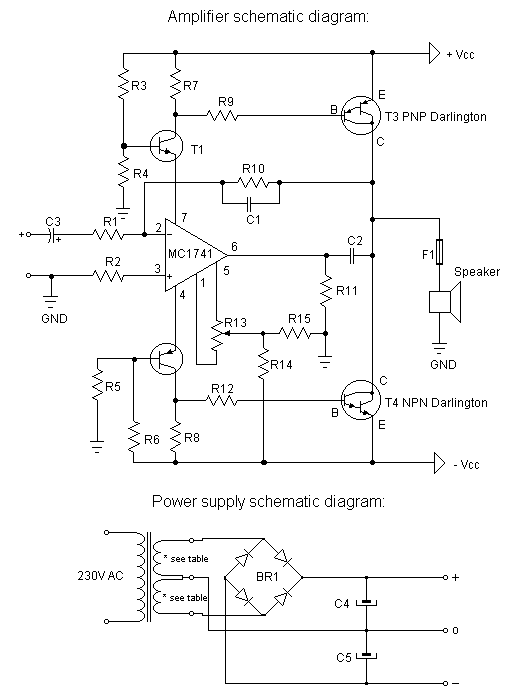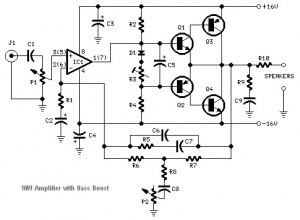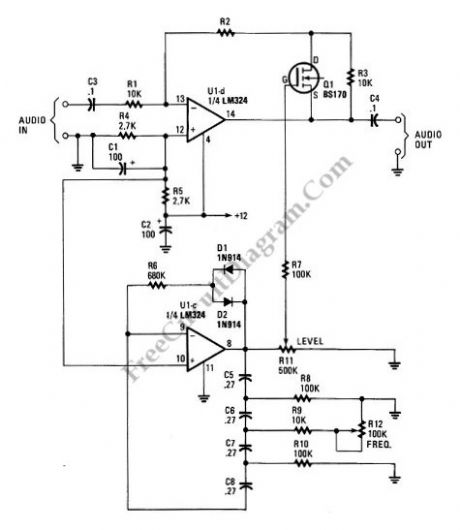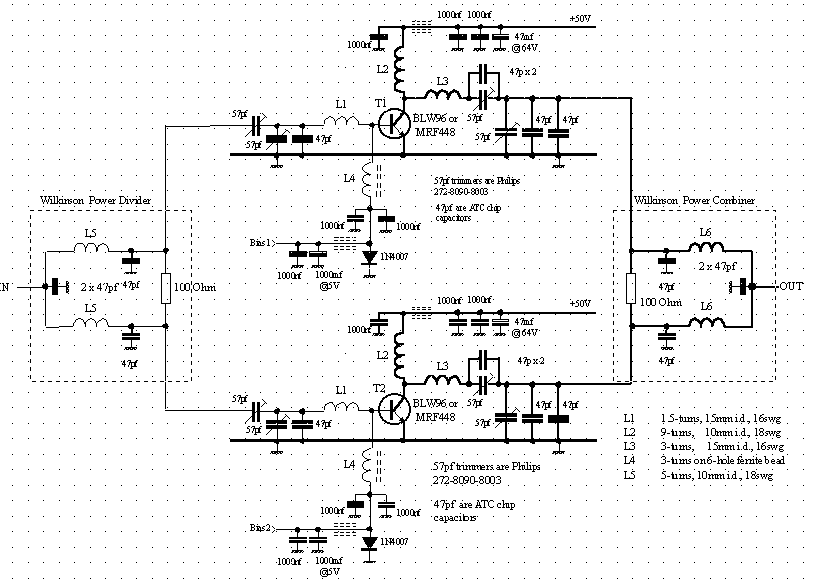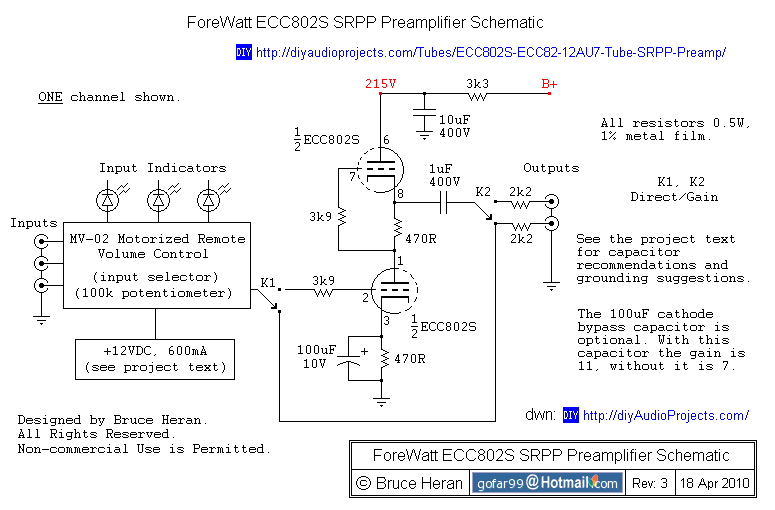
60W Guitar Amplifier
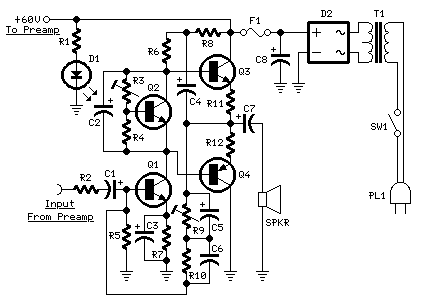
This design adopts a well established circuit topology for the power amplifier, using a single-rail supply of about 60V and capacitor-coupling for the speaker(s). The advantages for a guitar amplifier are the very simple circuitry, even for comparatively high power outputs, and a certain built-in degree of loudspeaker protection, due to capacitor C8, preventing the voltage supply to be conveyed into loudspeakers in case of output transistors' failure. More: Bass, Treble, Harmonic modifier and Brightness controls. Output power: 40W on 8 Ohm and 60W on 4 Ohm loads. The preamp is powered by the same 60V rails as the power amplifier, allowing to implement a two-transistors gain-block capable of delivering ab.
This circuit design utilizes a single-rail power supply of approximately 60V, which is a common choice for high-power audio applications such as guitar amplifiers. The power amplifier section employs a capacitor-coupling method to connect to the load (speakers), which serves to block any DC voltage from reaching the speakers, thereby protecting them from potential damage due to output transistor failure. The inclusion of capacitor C8 is particularly noteworthy as it adds an additional layer of protection by preventing high voltages from being transmitted to the speakers in the event of a fault.
The amplifier is designed to deliver a power output of 40W into an 8-ohm load and 60W into a 4-ohm load, making it versatile for different speaker configurations. The output stage is likely to be a push-pull configuration, which is typical for achieving higher power levels while maintaining linearity and minimizing distortion.
The preamp stage, which shares the same 60V supply, consists of a two-transistor gain-block configuration. This design approach is effective for achieving significant amplification while maintaining a compact footprint. The preamp also incorporates controls for bass, treble, harmonic modification, and brightness, allowing for extensive tonal shaping. These controls enable users to customize the sound output to suit their preferences and playing style, which is essential in a guitar amplifier context.
Overall, the circuit design is characterized by simplicity and effectiveness, making it suitable for both amateur and professional applications in guitar amplification. The thoughtful integration of protective components and tonal controls enhances the usability and reliability of the amplifier, ensuring it meets the demands of guitarists seeking both performance and sound quality.This design adopts a well established circuit topology for the power amplifier, using a single-rail supply of about 60V and capacitor-coupling for the speaker(s). The advantages for a guitar amplifier are the very simple circuitry, even for comparatively high power outputs, and a certain built-in degree of loudspeaker protection, due to capacitor C8, preventing the voltage supply to be conveyed into loudspeakers in case of output transistors` failure.
Bass, Treble, Harmonic modifier and Brightness controls Output power: 40W on 8 Ohm and 60W on 4 Ohm loads The preamp is powered by the same 60V rails as the power amplifier, allowing to implement a two-transistors gain-block capable of delivering ab 🔗 External reference
This circuit design utilizes a single-rail power supply of approximately 60V, which is a common choice for high-power audio applications such as guitar amplifiers. The power amplifier section employs a capacitor-coupling method to connect to the load (speakers), which serves to block any DC voltage from reaching the speakers, thereby protecting them from potential damage due to output transistor failure. The inclusion of capacitor C8 is particularly noteworthy as it adds an additional layer of protection by preventing high voltages from being transmitted to the speakers in the event of a fault.
The amplifier is designed to deliver a power output of 40W into an 8-ohm load and 60W into a 4-ohm load, making it versatile for different speaker configurations. The output stage is likely to be a push-pull configuration, which is typical for achieving higher power levels while maintaining linearity and minimizing distortion.
The preamp stage, which shares the same 60V supply, consists of a two-transistor gain-block configuration. This design approach is effective for achieving significant amplification while maintaining a compact footprint. The preamp also incorporates controls for bass, treble, harmonic modification, and brightness, allowing for extensive tonal shaping. These controls enable users to customize the sound output to suit their preferences and playing style, which is essential in a guitar amplifier context.
Overall, the circuit design is characterized by simplicity and effectiveness, making it suitable for both amateur and professional applications in guitar amplification. The thoughtful integration of protective components and tonal controls enhances the usability and reliability of the amplifier, ensuring it meets the demands of guitarists seeking both performance and sound quality.This design adopts a well established circuit topology for the power amplifier, using a single-rail supply of about 60V and capacitor-coupling for the speaker(s). The advantages for a guitar amplifier are the very simple circuitry, even for comparatively high power outputs, and a certain built-in degree of loudspeaker protection, due to capacitor C8, preventing the voltage supply to be conveyed into loudspeakers in case of output transistors` failure.
Bass, Treble, Harmonic modifier and Brightness controls Output power: 40W on 8 Ohm and 60W on 4 Ohm loads The preamp is powered by the same 60V rails as the power amplifier, allowing to implement a two-transistors gain-block capable of delivering ab 🔗 External reference
